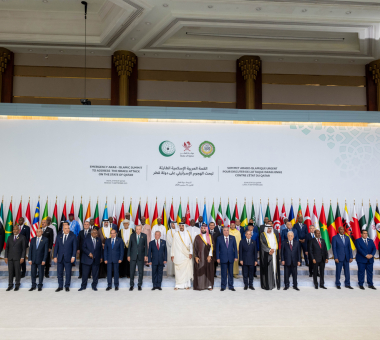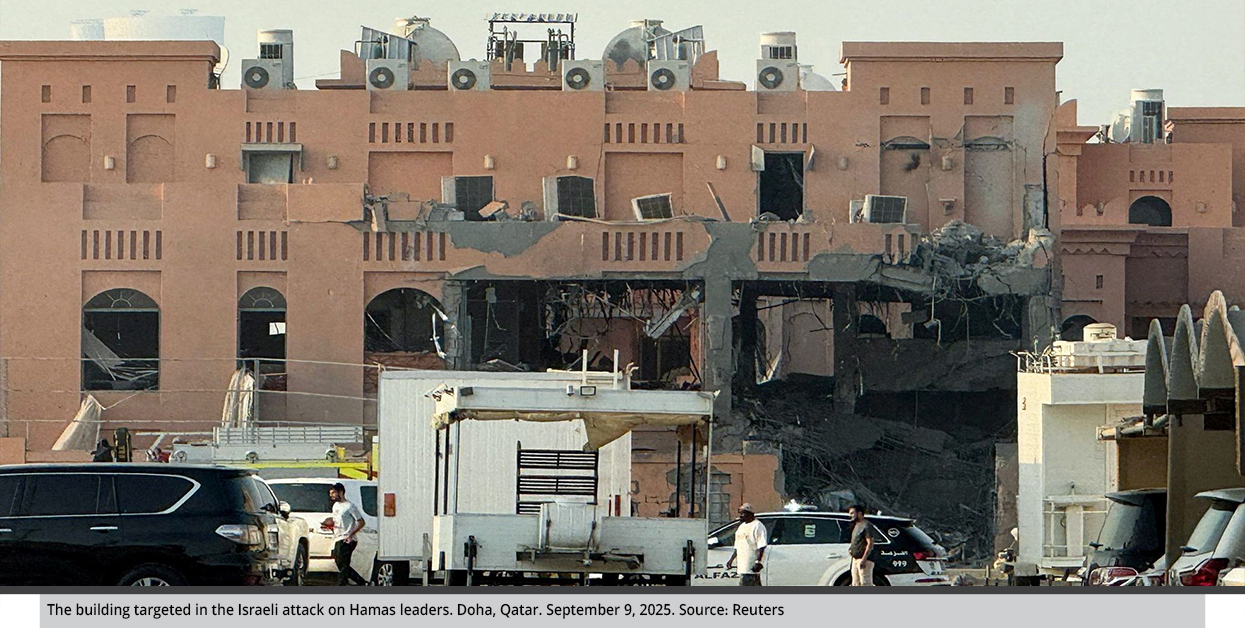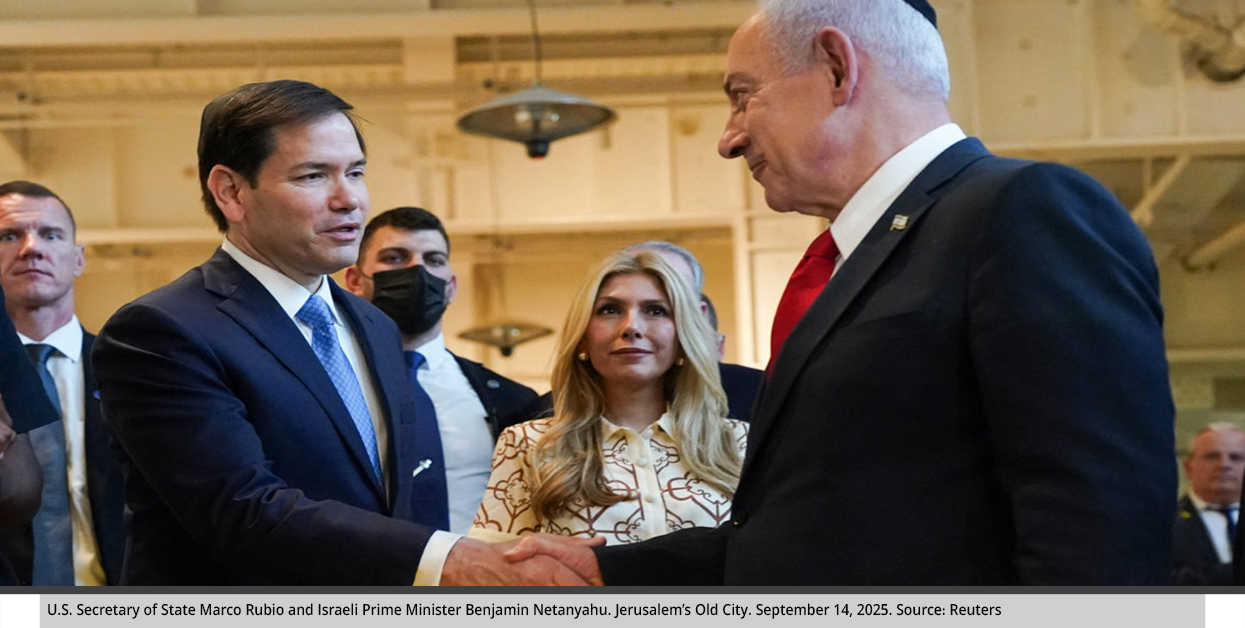The Outcomes of the Doha Emergency Summit and the Missed Arab Opportunity
The most important criterion for judging the outcomes of the Arab-Islamic summit in Doha this September remains the extent to which they are reflected in Israeli behavior. While the summit could serve as a barrier against Israel repeating attacks on Qatar or any other Arab state, it will not alter the developments on the ground, nor will it play a role in reshaping the balance of power in the Middle East—a matter of utmost priority and significance at both the Arab and regional levels.
by STRATEGIECS Team
- Release Date – Sep 17, 2025

An extraordinary Arab-Islamic summit in Doha, the capital city of Qatar, convened September 15 in a sensitive regional context following Israel’s unexpected airstrike targeting the Hamas negotiating delegation in Doha on September 9. Especially since the Israeli attack represented not only an unprecedented act against a Gulf state but one that is a mediator directly involved in negotiations between Hamas and Israel, Arab and Islamic leaders quickly joined forces to discuss ways of responding to Israel.
All this comes in light of the ongoing war in the Gaza Strip and Israel’s growing reliance on military force. Qatar has become the seventh regional country or territory—Iran, Iraq, Lebanon, Palestine (Gaza and the West Bank), Qatar, and Syria—to come under Israeli strikes. For Qatar specifically, this was the second attack linked to the war, following Iran’s missile strikes on Qatar’s Al-Udeid Air Base in retaliation for the June 22 U.S. airstrike on Iran’s central nuclear facilities.
Reading the Final Communiqué of the Summit
The summit’s final communiqué was striking in its content. It included a strong condemnation of the attack, a rejection of its justifications, and a warning against its recurrence. Arab and Islamic states affirmed their support for Qatar in the measures it takes in response to Israel and categorically rejected Israel’s threats to repeat the attack.
The communiqué also broadened its scope by addressing the ongoing war in the Gaza Strip. It condemned Israel’s plans in both the West Bank and Gaza, its role in creating the unprecedented humanitarian crisis in Gaza, and its attempts to annex the West Bank. Furthermore, it reiterated support for the Arab plan to rebuild the Gaza Strip.
The communiqué also considered the Israeli attack a threat to international peace and stability. It tasked the 57 member states of the Organisation of Islamic Cooperation with enforcing the arrest warrants issued by the International Criminal Court on November 21, 2024. It further emphasized commitment to the provisional measures ordered by the United Nation’s International Court of Justice on January 26, 2024, supplementing this by classifying blockade and starvation as war crimes, and forced displacement as a crime against humanity.
In addition, the leaders’ speeches reflected a state of anger toward Israel’s conduct in the region:
- Egyptian President Abdel Fattah el-Sisi warned that such behavior could widen the scope of the conflict and push the region into a dangerous spiral of escalation, especially since, as the president noted, Israel has crossed “all red lines.”
- King Abdullah II ibn Al Hussein of Jordan called for a clear, decisive, and deterrent Arab and Islamic response to Israeli threats, urging practical decisions to halt the war in the Gaza Strip.
- Turkish President Recep Tayyip Erdoğan demanded that Israel be deterred through sanctions consistent with international law, stressing the need to activate joint mechanisms among Arab and Islamic countries.
- Iraqi Prime Minister Mohammed Shia’ al-Sudani proposed forming a joint Arab-Islamic committee to operate at the international and UN levels.
Although the leaders’ speeches at the summit included clear calls for practical measures, the final communiqué remained limited to three main pillars that reflected a more cautious tone. It reaffirmed the Arab and legal principles established by the United Nations and related international bodies, confined itself to the immediate context of the summit and its direct trigger, and framed deterrent executive measures as mere “calls” rather than binding commitments.
These included important appeals such as imposing sanctions on Israel; suspending the supply of weapons, military materials, or dual-use goods; reviewing economic and diplomatic relations with Israel; and reconsidering its UN membership with the possibility of suspension. This effectively turned action into an individual initiative rather than a collective one, making implementation highly difficult—particularly due to strategic interests and the desire to avoid repercussions or overlapping partnerships—thus making it unlikely that the summit’s outcomes will be translated into concrete actions.

The Summit’s Context and the Realities of the War
The Arab-Islamic summit in Doha is the fourth of its kind to be convened in direct connection with the war in the Gaza Strip. The first response came with the joint Arab-Islamic summit in Riyadh in November 2023, followed by a second joint summit in Riyadh in November 2024, and then the Arab summit in Cairo in February 2025, at which the Arab plan for Gaza’s reconstruction was approved.
In addition, Jordan hosted the “Call for Action: Urgent Humanitarian Response for Gaza” conference on June 11, 2024, with representatives from 75 countries, as well as international humanitarian and relief organizations, to coordinate efforts in addressing the unprecedented humanitarian crisis in the Gaza Strip.
Nevertheless, the Doha summit—through its context and underlying factors—reveals both the evolving dynamics of the war and the widening scope of its repercussions, as well as the growing complexity of the network of direct and indirect actors involved.
On one hand, Israel’s attack on the Hamas delegation came after a series of developments triggered by the “comprehensive deal” announced August 2 by U.S. Special Envoy to the Middle East Steve Witkoff. From the perspective of both the United States and Israel, the deal aligned with field realities in the Gaza Strip, effectively bypassing Hamas and its capacity to manage the Strip or the negotiations. Thus, the deal was presented unilaterally, without consulting the Hamas delegation or the Qatari and Egyptian mediators.
This came just days after Israel announced its withdrawal from the framework of the “June Negotiations” on July 24, followed by U.S. President Donald Trump’s warning on September 8—described as a “final warning”—that Hamas must accept the proposal.
On the other hand, the attack on Qatar is closely tied to the ongoing fluctuations in its unofficial relations with Israel since the outbreak of the war, largely due to Qatar’s role in and support for Hamas. Doha has faced Israeli and American accusations of collusion through its financial and political backing of Hamas.
This narrative was invoked by Israeli Prime Minister Benjamin Netanyahu on January 24, 2024, when he accused Qatar of funding Hamas and failing to exert pressure for the release of hostages. It was also reflected in a letter U.S. Secretary of State Antony Blinken sent to Qatari Prime Minister and Foreign Affairs Minister Mohammed bin Abdulrahman Al Thani on March 5, 2024.
The same narrative resurfaced just hours after the attack on the Hamas delegation, when Netanyahu issued a warning letter on September 10 demanding that Qatar expel Hamas leaders or put them on trial.
Post-Summit Developments and Outcomes
The summit’s final communiqué included exceptional references and notable calls compared to previous summits, issuing a broad and strong condemnation from both Arab and Islamic states. However, while the summit clearly defined the forbidden action that Israel should not repeat, its outcomes fell short of achieving a true level of deterrence.
For instance, the summit focused on warning Israel against carrying out another attack on Qatar, which may have been prompted by Netanyahu’s renewed threat on September 13 to target Hamas leaders in Qatar. Additionally, the regional and international significance of Gulf security contributed to the widespread regional and international condemnation Israel faced after the attack.
However, the summit did not clarify the consequences of repeating such an attack; therefore, its outcomes did not constitute an effective deterrent against Israel. Its focus remained a restricted response to the specific attack, convened at Qatar’s invitation, yet it overlooked the broader, evolving regional realities shaped by the ongoing war and its repercussions in the Gaza Strip.
Shortly after the summit, Israel launched “Gideon’s Chariots 2” on September 16, a military offensive targeting Gaza City in the central Gaza Strip, with the Israeli army announcing the penetration of its armed forces deep into the city. This followed Netanyahu’s warning on September 8 for Gaza residents to evacuate the city.
On the other hand, the summit did not address one of the main motivations behind Israel’s attack: the creation of a regional scenario that Tel Aviv seeks to control and dominate. This includes Israel’s continued control over border points in both Syria and Lebanon, as well as its limited but ongoing military air and ground campaigns in both countries.
In addition, the Israeli attack on Qatar marked the first such strike since the outbreak of the war against a country outside the “Iranian axis.” Practically, this reflects Israel’s narrative of superiority and its high operational capability to reach any point in the region—a message previously echoed during its attacks on Iran, Yemen, and then Qatar. This indicates the widening scope of Israeli aggression and its connection to expansionist Israeli rhetoric directed at the neighboring countries, specifically Jordan and Egypt—an aspect overlooked by the summit’s outcomes.
Moreover, the summit did not take into account the most important variable: the stance of the Trump administration, which appears closely aligned with the Israeli government. The administration had previously engaged with Israeli plans to displace residents of the Gaza Strip.
While Trump warned Israel in its dealings with Qatar, considered a U.S. ally, at the same time as the summit, U.S. Secretary of State Marco Rubio visited Israel—a visit Netanyahu described as a clear message of Washington’s support for Israel.
Rubio endorsed the necessity of dismantling Hamas and demanded action toward that end, yet he also sought to mitigate tensions with Qatar and balance relations among allies, as reflected in his visit to Qatar on September 16 and his announcement of the imminent signing of an enhanced defense agreement with the country.

The Missed Opportunity?
The summit was held amid deep geopolitical upheavals in the region. The October 2023 attacks against Israel reshaped the contours of the regional balance, altered existing deterrence equations, and led to a noticeable decline in Iranian influence. Meanwhile, Israel pursued rhetoric and measures aimed at consolidating its image as a rising power and presenting itself as the new architect of the emerging regional order, relying primarily on its military strength to achieve this.
In contrast, Arab states demonstrate a greater degree of realism in their rejection of returning the region to the cycle of power struggles that dominated from the 1940s to the 1970s. Their avoidance of military retaliation in response to sporadic Israeli attacks or violations of Arab airspace is mainly due to several factors. Foremost among them is a rational assessment of the costs of past Arab-Israeli wars and the consequences of resorting to military solutions, as witnessed in the 2003–2011 Second Gulf War.
Additionally, the concept of collective Arab security has weakened due to divergent priorities and multiple approaches among Arab countries. This prompted Assistant Secretary-General of the League of Arab States Hossam Zaki to state that the current climate is not conducive to activating the Joint Arab Defense Agreement.
Nevertheless, experiences of Arab withdrawal from key regional events—such as the 2003 U.S.-led invasion of Iraq and developments following the “Arab Spring” since 2012—demonstrate the significant repercussions on the regional security system, reflecting a shift of the Arab role from one of initiative to one of caution and situational response.
The Doha summit represented a missed opportunity for Arab states to move from rhetoric to action, foremost by reassessing and redefining deterrence tools to counter Israel’s rising influence. However, the summit did not clarify the cost of directly targeting Qatar, nor did it demonstrate any real willingness to implement its outcomes, which, as noted earlier, were framed as non-binding “calls.”
Consequently, the summit failed to employ non-military tools of Arab deterrence against Israeli policies, whether through economic pressure, diplomatic isolation, psychological and media influence, or even information warfare. These were measures that could have had a tangible impact, especially given Netanyahu’s acknowledgment that Israel faces a growing diplomatic isolation as a result of its ongoing war in the Gaza Strip.
In contrast, the final communiqué of the extraordinary session of the Gulf Cooperation Council (GCC) Supreme Council—held on the sidelines of the Doha summit—demonstrated greater seriousness and clarity in its outcomes. It called for the High Military Committee to convene to assess the defense situation and sources of threat, and it directed the Unified Military Command to activate joint defense mechanisms and strengthen Gulf deterrence capabilities. This reflects a deliberate, scalable approach that can evolve alongside emerging security and regional challenges.
Compared to the Doha summit’s outcomes, this communiqué highlights a clear divergence in approaches to regional challenges. While the Doha summit limited itself to strong condemnation without executive mechanisms or directives, the GCC took practical decisions and issued operational guidance. GCC measures could potentially expand to include closer cooperation with Jordan and Egypt, which are directly in contact with Israeli threats. The strategic significance of Qatari Emir Tamim bin Hamad Al Thani’s September 17 visit to Jordan to meet with King Abdullah II further underscores the close interconnection of regional security among the states of the region.
Finally, the most important criterion for judging the outcomes of the Doha summit remains the extent to which they are reflected in Israeli behavior. While the summit could serve as a barrier against repeating attacks on Qatar or any other Arab state, it will not alter the developments on the ground, nor will it play a role in reshaping the balance of power in the Middle East—a matter of utmost priority and significance at both the Arab and regional levels.

STRATEGIECS Team
Policy Analysis Team
 العربية
العربية